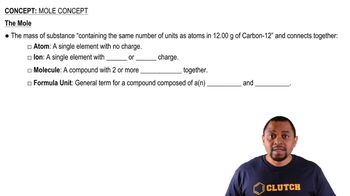Textbook Question
Refer to the nomenclature flowchart (Figure 3.11) to name each compound. c. CoSO4
 Verified step by step guidance
Verified step by step guidance



Refer to the nomenclature flowchart (Figure 3.11) to name each compound. c. CoSO4
Calculate the formula mass for each compound. c. H2SO4
Calculate the formula mass for each compound. a. N2O4
Determine the number of moles (of molecules or formula units) in each sample. b. 23.6 kg Fe(NO3)2
Determine the number of moles (of molecules or formula units) in each sample. c. 0.1187 g C8H18
Determine the number of moles (of molecules or formula units) in each sample. d. 195 kg CaO